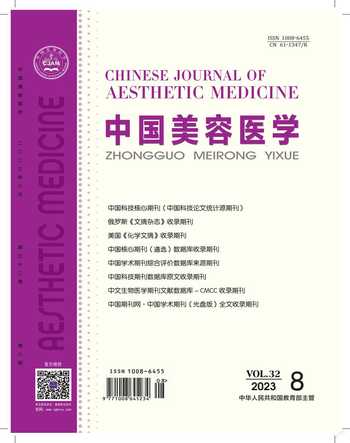Spee曲线的形成及其生理性变化研究进展
任银婷 韩晶莹
[摘要]Spee曲线主要描述矢状向下牙列的牙合面形态特征,在正畸和修复的临床治疗中都是需要考虑的重要因素,了解其发生发展的相关规律有助于不同患者个别正常牙合的实现。目前对于Spee曲线形成、生长发育规律及增龄性变化研究有限,文献复习结果表明,Spee曲线的形成是口颌面结构的生长、牙齿的萌出以及神经肌肉系统的发育之间相互作用的结果,也可能是由于发育过程中代偿机制的存在,生长发育过程中其深度主要随恒牙的萌出而发生变化,其他因素的影响还需进一步研究。生长发育结束后,可能由于牙齿的磨耗、第三磨牙的萌出等因素而发生改变。目前Spee曲线的生理性变化规律还没有形成共识,本文就有关研究进展进行总结,旨在为进一步研究及临床实践提供参考。
[关键词]Spee曲线;形成机制;固有补偿机制;生长发育;增龄性变化;错牙合畸形;牙齿萌出
[中图分类号]R783.5 [文献标志码]A [文章编号]1008-6455(2023)08-0198-04
Research Progress on the Formation for the Curve of Spee and Its Correlation
with Age
REN Yinting,HAN Jingying
(Department of Orthodontics,the Second Affiliated Hospital of Harbin Medical University,Harbin 150000,Heilongjiang,China)
Abstract: The curve of Spee mainly describes the morphological characteristics of the sagittal mandibular dentition, which is an important factor to be considered in the clinical treatment of orthodontics and restorative dentistry. Understanding the related rules of its occurrence and development is helpful for the realization of individual normal occlusion in different patients. At present, there are limited studies on its formation, growth and development and age-related changes. Literature review shows that the formation of the curve of Spee is the result of the interaction between the growth of orofacial structures, teeth eruption and the development of the neuromuscular system, or it may be due to the existence of compensatory mechanism during growth and development. Its depth mainly changes with the eruption of permanent teeth, and the influence of other factors needs to be further studied. After the growth and development, the curve of Spee may change due to the wear of teeth, third molar eruption and other factors. At present, there is no consensus on the physiological change law of the curve of Spee, this paper summarizes the relevant research progress, aiming to provide references for further research and clinical practice.
Key words: the curve of Spee; formation mechanism; inherent compensation mechanism; growth and development; aging changes; malocclusion; tooth eruption
Spee曲線是解剖学上的一个弯曲[1],最早由德国学者Spee FG[2]于1890年描述为连接下颌切牙切缘、尖牙牙尖、前磨牙颊尖和磨牙近远中颊尖的矢状曲线。目前研究多认为,正常咬合时呈现出平坦的Spee曲线,并且Spee曲线在咀嚼过程中具有生物力学功能[3-5],所以在正畸治疗过程中通常会整平较深的Spee曲线,这对正畸治疗后牙列的稳定性具有重要意义,也有助于提高咀嚼效率[6]。目前,我们尚未完全理解Spee曲线的功能[7],对其形成和生长发育规律及增龄性变化的认识也十分有限[8]。因此,本文就目前Spee曲线与生长发育相关的研究进展做一综述。
1 Spee曲线的形成
目前的研究认为,Spee曲线的形成是多因素综合作用的结果,包括口颌面结构的生长、牙齿的萌出以及神经肌肉系统的发育等[8-11]。
1.1 口颌面结构的生长:通过比较是否存在Spee曲线的动物牙列,Spee FG[2]认为颞下颌关节结节结构是Spee曲线形成的重要因素,这一结构的存在使得下颌在前后运动过程中上下牙不分离,保证了最大的咬合接触。同时,Spee曲线深度的增加常见于短头颅面患者,与较短的下颌骨体相关,且Spee曲线与牙槽突曲线形态也基本一致,整平Spee曲线后的长期稳定性也受到垂直骨面型的影响[12]。因此,有学者提出Spee曲线以各种形式存在于哺乳动物中,与下颌骨相对于颅骨的矢状、垂直位置有关[13]。这均提示Spee曲线的形成与口颌面结构的生长相关,近年来相关研究不断证实了这些观点[14-15]。但就口颌面结构如何影响Spee曲线的形成尚未形成共识,且基于形态学的研究和头影测量的结果还不能准确推测Spee曲线的形成[10],具体机制仍需进一步研究。
1.2 牙齿的萌出:Marshall SD[9]的有限元模型研究结果表明,Spee曲线的深度似乎取决于下颌骨咀嚼运动的半径长度,并且上下頜的空间关系与下颌的功能有助于牙合曲线的发展。以往有研究认为[10],Spee曲线最初于下颌第一恒磨牙和中切牙萌出时形成,之后也随其他恒牙萌出而发生变化,这都表明Spee曲线的形成与牙齿萌出密切相关。
1.3 神经肌肉系统的发育:Mew J[16]对Marshall研究中忽略舌体对Spee曲线形成的作用提出质疑,认为Spee曲线加深可能是由于舌体侧向扩张导致,并且正确的咬合位置很大程度上取决于舌体的位置,Marshall表示需要考虑肌肉及其他多方面因素的影响才能充分解释Spee曲线的形成,他之后提出,Spee曲线的形成受肌肉和韧带附着所决定的路径限制[9]。Spee曲线的变化将直接影响到面部下1/3的软组织形态[17],而神经肌肉系统发育与Spee曲线形成之间的相互作用还需更深入的研究。
除以上研究外,Enlow D等[18]认为下颌在生长发育过程中向下向后的旋转带来了牙弓的向下移动,出现开牙合的趋势,由于固有补偿机制存在,这种趋势被下颌前牙向上移动和上颌前牙向下移动所代偿,从而产生了曲线状的Spee曲线。除此之外,发育型为长面型或气道等其他原因导致下颌角变大,颅前窝的位置变化会带来腭平面和上颌基骨弓逆时针旋转,各种造成开牙合倾向的因素汇集便会导致Spee曲线出现来代偿,使前方开牙合不完全表现出来。每当下颌升支和下颌体间的角度发生变化时,多个部位便开始发生改建,而下颌体通常并不发生直接向上改建和下缘骨吸收,但会发生明显的牙槽骨向上生长和下前牙上移。这种从生长发育角度阐释Spee曲线产生的理论目前被众多学者广泛接受。
2 Spee曲线的生长发育规律
在青春期结束之前,随着机体的生长发育,Spee曲线的变化也会呈现出一定规律。Kubein D等[19]认为,Spee曲线的个体发育主要取决于咬合、关节结构的排列,不同个体前后牙形态以及它们与颞下颌关节的空间关系。近年来主要从不同生长发育阶段Spee曲线的特点来阐释Spee曲线的生长发育规律。
Marshall D等[10]测量4~26岁志愿者的Spee曲线深度,结果显示Spee曲线深度在乳牙列中最小,在替牙期下颌第一恒磨牙和中切牙萌出时显著增加,然后基本保持不变,直到第二恒磨牙萌出时再次加深[20],在青春期略有减小,然后保持相对稳定直到成年初期[21]。这是第一份纵向测量Spee曲线深度的报道,比较完整地描述了Spee曲线在整个生长发育过程中的变化,结果表明这种变化的发生主要是由于牙齿萌出[5]。Gagliardi A等[22]认为Spee曲线深度的最大变化发生在混合牙列和恒牙列之间,而在乳牙列和混合牙列相对平坦。而Al-Qawasmi R等[6]对平均年龄为12岁7个月的人群研究结果则表明,Spee曲线深度随着患者年龄增长趋于平坦,这与以上研究相矛盾。笔者认为这种现象的发生可能是由于使用了第一磨牙作为远中的参考点,或者是牙列未完全萌出及下颌骨的生长旋转所致。其他学者则对生长发育的某些阶段进行研究。Carter GA等[23]的回顾性实验研究结果显示,Spee曲线深度仅在男性样本平均年龄13.9岁和16.9岁两组间有显著下降,在女性样本中下降相对不明显,成年后男女性均保持稳定。Veli I等[24]根据志愿者的颈椎成熟度分组,选择CS3、CS4、CS5三个阶段测量Spee曲线深度,发现样本的Spee曲线深度有所减小。以上研究从同一个研究模型中选择样本,尽管选择标准有差异,但在相似的年龄阶段得出的结论是基本一致的,即Spee曲线深度在生长发育中晚期会有一定程度的减小。Massaro C等[25]的研究也同意这一观点。
以上的纵向研究基本认可进入生长发育中晚期,在下颌第二恒磨牙建牙合后Spee曲线深度有所减小,宗丽娜[26]在正畸科就诊人群中进行的横向研究也支持以上结论。但也有研究得出不同的结论,Kumari N等[15]对平均年龄为(16.1±3.6)岁的114例患者的研究则认为Spee曲线深度与年龄不存在统计学上的相关性。Spee曲线随生长发育加深受牙性因素影响较大,目前多认为主要是由于下颌牙齿的萌出相对于上颌牙较早,没有对牙合限制的下颌恒牙生长导致Spee曲线加深[10,27]。但在生长发育早期Spee曲线变化的研究较少,同时样本量小是以上研究中普遍存在的局限性,要得出普遍认可的Spee曲线生长发育规律尚需要覆盖整个发育阶段的大样本研究。
3 Spee曲线的增龄性变化
生长发育完成后,随着年龄的不断增长,口腔内组织器官可能发生各种变化。基于不同受试对象与研究手段,学者们对Spee曲线深度的增龄性变化持有不同观点。Dager MM等[28]测量志愿者青春期后到60岁的牙弓变化,结果显示在整个过程中Spee曲线深度并未呈现出明显变化,保持显著的稳定性,这与他们之前的研究成年后样本的变化相一致[24],Massaro C等[25]的研究表明志愿者在17~60岁Spee曲线深度表现出相似的稳定性。Halimi A等[29]、Surendran SV等[30]的研究得出相似结论。但也有研究显示Spee曲线深度在生长发育完成后会出现一定的增龄性变化。Mohan M等[31]横向研究Spee曲线深度随年龄的变化,结果显示Spee曲线半径显著增加,表明Spee曲线随年龄增长逐渐平坦,他们认为这种改变主要是由于随着年龄的增长,牙齿的磨耗会增加,进而导致Spee曲线深度表现出随年龄增长而自然减小[32]。Fiorin E等[33]的研究得出了相似的结论,牙齿磨耗的程度和位置会影响咬合的形式,进而影响Spee曲线。
就磨耗是否會影响Spee曲线的深度这一问题,Karani J等[34]将70例20~50岁健康人群分为正常牙列和存在磨耗牙列两组测量Spee曲线的深度,结果显示两组牙列Spee曲线深度没有显著差异,这与以上结果不一致,牙齿磨耗对Spee曲线深度的影响还需要进一步的研究。Andrews LF[3]认为Spee曲线随时间推移有加深的自然趋势,他认为这是由于下颌向下向前的生长有时会快于上颌,并且持续时间比上颌长,而下前牙由于受到上前牙和嘴唇的限制,被迫向上向后移动,引起Spee曲线的加深[35]。同时下颌第三磨牙即使在生长停止后也会对牙弓产生向前的推力,同样会导致Spee曲线加深。随着人类的进化,颌骨的退化与牙齿的退化不一致,导致骨量相对小于牙量,颌骨缺乏足够的空间容纳全部牙齿,引起牙齿阻生,下颌第三磨牙是牙弓中最常见的阻生牙。现代人阻生的下颌第三磨牙更可能对牙弓产生向前的推力引起Spee曲线的加深,但目前笔者还没有发现有定量的研究支持这一观点,Spee曲线在生长发育完成后的增龄性变化还存在比较大的争议。
目前,对Spee曲线的形成机制、生长发育规律以及增龄性变化的研究有限,且相关研究没有统一的Spee曲线测量标准,研究样本量较少,难以得出普遍认可的Spee曲线的生理性变化规律。对于正畸和修复临床医师而言,掌握相应的变化有利于根据患者所处的不同阶段调整Spee曲线深度以满足调整咬合的需要,提高治疗的稳定性,但目前还有待进一步的研究丰富现有认识,为更精准的治疗方案提供理论基础。
[参考文献]
[1]Sayar G,Oktay H.Assessment of curve of spee in different malocclusions[J].Eur Oral Res,2018,52(3):127-130.
[2]Spee F G,Biedenbach M A,Hotz M,et al.The gliding path of the mandible along the skull[J].J Am Dent Assoc,1980,100(5):670-675.
[3]Andrews L F.The six keys to normal occlusion[J].Am J Orthod,1972,62(3):
296-309.
[4]Vieira B,Freitas K M S.What about the curve of Spee?[J].Am J Orthod Dentofacial Orthop,2021,159(4):408.
[5]Nazruddin N,Yan Yu T.Evaluation of the depth of the curve of spee, overjet, and overbite in Class Ⅰ, Class Ⅱ, and Class Ⅲ malocclusion among patients at university of north sumatera dental hospital[C].Atlantis Press,2018.
[6]Al-Qawasmi R,Coe C.Genetic influence on the curves of occlusion in children seeking orthodontic treatment[J].Int Orthod,2021,19(1):82-87.
[7]Aboulfotouh M H,El-Dawlatly M M.The relationship between the depth of the curve of Spee and different types of malocclusion[J].Eg Orthod J,2020,58:19-25.
[8]Hampe T,Krohn S,Schmitt F,et al.The variability of the curve of Spee:An analysis of multiple setups of the same Angle Class I patient case[J].J Orofac Orthop,2020,81(2):89-99.
[9]Marshall S D,Kruger K,Franciscus R G,et al.Development of the mandibular curve of spee and maxillary compensating curve: A finite element model[J].PloS One,2019,14(12):e0221137.
[10]Marshall S D,Caspersen M,Hardinger R R,et al.Development of the curve of Spee [J].Am J Orthod Dentofacial Orthop,2008,134(3):
344-352.
[11]Mujib M,Abid A M,Khan M A.Correlation of curve of Spee with maxillo-mandibular discrepancy among different malocclusion groups[J].Pakistan Armed Forces Med J,2018,68(2):379-383.
[12]Rozzi M,Mucedero M,Pezzuto C,et al.Long-term stability of curve of Spee levelled with continuous archwires in subjects with different vertical patterns: a retrospective study[J].Eur J Orthod,2019,41(3):286-293.
[13]Jan A,Nayak R S,Kavya B,et al.Correlation between curve of Spee and various dental and skeletal cephalometric parameters. A radiological study[J].Int J Appl Dent Sci,2020,6:183-188.
[14]Laird M F,Holton N E,Scott J E,et al.Spatial determinants of the mandibular curve of Spee in modern and archaic Homo[J].Am J Phys Anthropol,2016,161(2):226-236.
[15]Kumari N,Fida M,Shaikh A.Exploration of variations in positions of upper and Lower incisors, overjet, overbite, and irregularity Index in orthodontic patients with dissimilar depths of curve of Spee[J].J Ayub Med Coll Abbottabad,2016,28(4):766-772.
[16]Mew J.The curve of Spee[J].Am J Orthod Dentofacial Orthop,2009,
135(1):3.
[17]Tremont T J,Posnick J C.Selected orthodontic principles for management of cranio-maxillofacial deformities[J].Oral Maxillofac Surg Clin North Am,2020,32(2):321-338.
[18]Enlow D,Mg H,林久祥译.颅面生长发育学[M].北京:北京大学医学出版社,2012:163-165.
[19]Kubein D,J?ger A,Hoffmann G.[The sagittal compensation curve and its variation with age as an expression of age-related form and structural changes of the mandible. A theoretical and statistical study][J].Fortschr Kieferorthop,1986,47(1):48-66.
[20]Fowler P,Haworth J,Steenberg L.Vertical segmental anterior mandibular distraction to aid closure of a severe anterior open bite associated with an accentuated reverse curve of Spee[J].J Orthod,2021,48(4):444-450.
[21]Rizwan S,Faisal S S,Hussain S S.Association of curve of spee with vertical skeletal patterns[J].JPDA,2020,29(4):254-258.
[22]Gagliardi A.The development of the curve of spee in Australian twins[D].School of Dentistry Faculty of Health Sciences:The University of Adelaide South Australia,2013.
[23]Carter G A,Mcnamara J A Jr.Longitudinal dental arch changes in adults[J].Am J Orthod Dentofacial Orthop,1998,114(1):88-99.
[24]Veli I,Ozturk M A,Uysal T.Curve of Spee and its relationship to vertical eruption of teeth among different malocclusion groups[J].Am J Orthod Dentofacial Orthop,2015,147(3):305-312.
[25]Massaro C,Miranda F,Janson G,et al.Maturational changes of the normal occlusion: A 40-year follow-up[J].Am J Orthod Dentofacial Orthop,2018,154(2):188-200.
[26]宗麗娜,王小琴.安氏Ⅱ类不同年龄Spee曲线形态特征[J].口腔医学研究,2020,36(5):462-464.
[27]Lee Y H,Tseng Y C.Curve of Spee: development and orthodontic leveling[J].Taiwanese J Orthod,2020,30(2):4.
[28]Dager M M,Mcnamara J A,Baccetti T,et al.Aging in the craniofacial complex [J].Angle Orthod,2008,78(3):440-444.
[29]Halimi A,Benyahia H,Azeroual M F,et al.Relationship between the curve of Spee and craniofacial variables: A regression analysis[J].Int Orthod,2018,16(2):361-373.
[30]Surendran S V,Hussain S,Bhoominthan S,et al.Analysis of the curve of Spee and the curve of Wilson in adult Indian population: A three-dimensional measurement study[J].J Indian Prosthodont Soc,2016,16(4):335-339.
[31]Mohan M,D'souza M,Kamath G,et al.Comparative evaluation of the curve of Spee in two age groups and its relation to posterior teeth disclusion[J].Indian J Dent Res,2011,22(1):179.
[32]Krishnamurthy S,Hallikerimath R B,Mandroli P S.An assessment of curve of Spee in healthy human permanent dentitions: a cross sectional analytical study in a group of young indian population[J].J Clin Diagn Res,2017,11(1):zc53-zc57.
[33]Fiorin E,Ibá?ez-Gimeno P,Cadafalch J,et al.The study of dental occlusion in ancient skeletal remains from Mallorca (Spain): A new approach based on dental clinical practice[J].Homo,2017,68(3):157-166.
[34]Karani J,Idrisi A,Mistry S,et al.Comparative evaluation of the depth of curve of Spee between individuals with normal dentition and individuals with occlusal wear using conventional and digital software analysis techniques: An in vivo study[J].J Indian Prosthodont Soc,2018,18(1):61-67.
[35]Khatri J M,Sanap N B.Curve of Spee in orthodontics: a review article[J].IJAMSR,2018,1(2):7-12.
[收稿日期]2021-05-26
本文引用格式:任银婷,韩晶瑩.Spee曲线的形成及其生理性变化研究进展[J].中国美容医学,2023,32(8):198-201.

